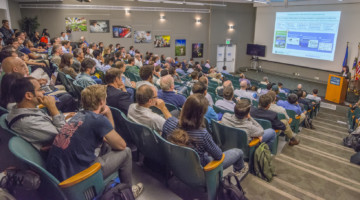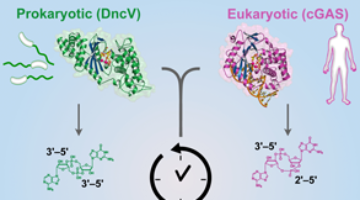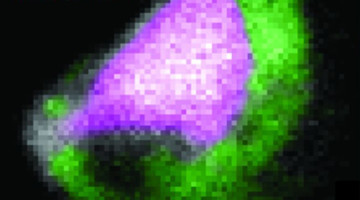The 2014 ALS User Meeting featured notable scientific speakers and a review of the year’s accomplishments as well as a look forward to dealing with challenging funding realities. In the midst of great talks and poster sessions, the more than 400 attendees were treated to the always informative and entertaining “Student Poster Slam,” which seems to grow every year. Read more »
All News & Updates
Giselle Jiles and Angel Hernandez, User Office
User office guest registration “specialists” Angel Hernandez and Giselle Jiles play a unique role at the ALS—they are often the first line of face-to-face contact new users have when they arrive for their beamtime. As such, the two see themselves as the caregivers of the ALS user experience.
A New Link Between Human and Bacterial Signaling Machinery
Researchers showed that a bacterial signaling protein critical for pathogenesis in Vibrio cholerae is actually a homolog of the human enzyme, cGAS, which detects invading DNA. These results reveal a surprising evolutionary connection between bacterial signaling and human innate immunity. Read more »
For the Birds: The Magic of Color in Feathers
The beauty and wild colors of bird feathers are derived from the combinations of relatively few molecules. Research at the ALS shows that the expression of colors (or melanin), depends on the proportion of the molecules.
Read more »
Skyrmion Behavior Revealed by Two X-Ray Studies
Two research groups have recently published separate studies in which soft x-rays reveal how skyrmions—quasiparticles made up of spin vortices—react to external fields. Their work lays the foundation for understanding these fascinating constructs and eventually utilizing them in spintronic applications. Read more »![]()
![]()
Space Dust Analysis Could Provide Clues to Solar System Origins
New studies of space dust captured by NASA’s Stardust Interstellar Dust Collector have shown that interstellar particles may be much more complex in structure and composition than previously thought. Read more »![]()
![]()
Ptychography: A Fun Word with Big Promise
We recently sat down with ALS physicist David Shapiro, lead author on the paper reporting this research in Nature Photonics, to talk about ptychography and why the ALS is uniquely suited to work on this next-generation technique. Read more »
Caribou Biosciences Has Roots at the ALS
When Rachel Haurwitz joined UC Berkeley biology professor Jennifer Doudna’s lab in 2007 as a graduate student, little did the two women know that the interesting bacterial immune system they were studying would be the subject of news headlines and the basis for a biotech startup just a few years later.
Infrared Mapping Helps Optimize Catalytic Reactions
A pathway to more effective and efficient synthesis of pharmaceuticals and other flow-reactor chemical products has been opened by a study in which, for the first time, the catalytic reactivity inside a microreactor was mapped in high resolution from start to finish. Read more »![]()
![]()
Validating Computer-Designed Proteins for Vaccines
Computationally designed proteins that accurately mimic key viral structures can help produce better vaccines. The resulting protein structures, validated at the ALS, encourage the further development of this strategy for a variety of vaccine targets, including HIV and influenza. Read more »![]()
![]()
- « Previous Page
- 1
- …
- 126
- 127
- 128
- 129
- 130
- …
- 136
- Next Page »






